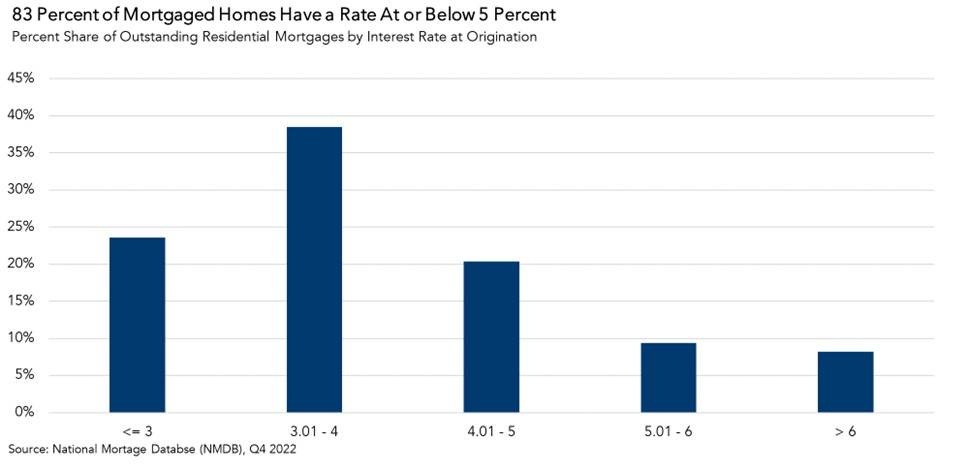The housing market remains sluggish heading into the spring home-buying season. While mortgage rates have retreated from recent peaks, they remain elevated compared with one year ago. Higher mortgage rates have a dual impact on sales – pricing out buyers who lose purchasing power and keeping some potential sellers rate-locked in. There are plenty of potential buyers sitting on the sidelines, but they are likely waiting for housing supply and affordability to improve before entering the market.
“It will be difficult for existing-home sales to meaningfully increase while homeowners remain chained to their homes by their golden handcuffs and confounded by the prisoner’s dilemma of whether to sell or not.”
Our Potential Home Sales Model, which measures what we believe a healthy market for home sales should be, based on the economic, demographic and housing market environments, increased modestly in April, but the primary factor holding back housing market potential was existing homeowners staying put.
Two Reasons Why Homeowners Are Staying Put
Tenure length is the number of years that a homeowner lives in their home, and it hit a new historic high of 10.7 years in April. There are two primary factors keeping existing homeowners in their homes.
The Golden Handcuffs of Low Mortgage Rates: Existing homeowners are hesitant to sell their homes because mortgage rates are above 6 percent, and 83 percent of existing homeowners have mortgages with rates below 5 percent. Why would anyone sell their home when it will cost significantly more each month to borrow the same amount from the bank?

When Your Castle Becomes Your Prison: The housing market is unlike most markets. Typically, the seller, or supplier, makes their decision to add supply to the market independent of the buyer, or source of demand, and their decision to buy. Yet, in the housing market, the seller and the buyer are in many cases the same – the existing homeowner. To buy a new home, you must sell the home you already own, and then find a home to buy. But not just any home – one that you like better. Every home is different – an almost perfectly heterogeneous good. The fewer homes there are for sale, the harder it becomes to find something better than what you already have.
Sellers face a prisoner’s dilemma, a situation in which individuals don’t cooperate with each other, even though it seems in their best interest to do so. If potential sellers all choose to sell, they would all benefit as buyers because they would increase the inventory of homes available and alleviate the supply shortage. However, the risk of selling if others don’t in a market with a shortage of inventory prevents many existing homeowners from selling altogether.
More than Just a Financial Decision
Of course, the decision to buy and sell is more than just a financial calculation. An existing homeowner may choose to sell for lifestyle reasons, even if it means losing their low mortgage rate. Additionally, 42 percent of homeowners own their home free-and-clear, so they are not deterred by higher mortgage rates. Even with these mitigating factors, it will be difficult for existing-home sales to meaningfully increase while homeowners remain chained to their homes by their golden handcuffs and confounded by the prisoner’s dilemma of whether to sell or not.
April 2023 Potential Home Sales
For the month of April, First American updated its proprietary Potential Home Sales Model to show that:
- Potential existing-home sales increased to a 5.34 million seasonally adjusted annualized rate (SAAR), a 0.45 percent month-over-month increase.
- This represents a 53.3 percent increase from the market potential low point reached in February 1993.
- The market potential for existing-home sales decreased 7.7 percent compared with a year ago, a loss of 443,350 (SAAR) sales.
- Currently, potential existing-home sales is 1,446,360 (SAAR), or 21.3 percent, below the pre-recession peak of market potential, which occurred in April 2006.
First American Deputy Chief Economist Odeta Kushi contributed to this post.
What Insight Does the Potential Home Sales Model Reveal?
When considering the right time to buy or sell a home, an important factor in the decision should be the market’s overall health, which is largely a function of supply and demand. Knowing how close the market is to a healthy level of activity can help consumers determine if it is a good time to buy or sell, and what might happen to the market in the future. That is difficult to assess when looking at the number of homes sold at a particular point in time without understanding the health of the market at that time. Historical context is critically important. Our potential home sales model measures what we believe a healthy market level of home sales should be based on the economic, demographic and housing market environments.
About the Potential Home Sales Model
Potential home sales measures existing-home sales, which include single-family homes, townhomes, condominiums and co-ops on a seasonally adjusted annualized rate based on the historical relationship between existing-home sales and U.S. population demographic data, homeowner tenure, house-buying power in the U.S. economy, price trends in the U.S. housing market, and conditions in the financial market. When the actual level of existing-home sales are significantly above potential home sales, the pace of turnover is not supported by market fundamentals and there is an increased likelihood of a market correction. Conversely, seasonally adjusted, annualized rates of actual existing-home sales below the level of potential existing-home sales indicate market turnover is underperforming the rate fundamentally supported by the current conditions. Actual seasonally adjusted annualized existing-home sales may exceed or fall short of the potential rate of sales for a variety of reasons, including non-traditional market conditions, policy constraints and market participant behavior. Recent potential home sale estimates are subject to revision to reflect the most up-to-date information available on the economy, housing market and financial conditions. The Potential Home Sales model is published prior to the National Association of Realtors’ Existing-Home Sales report each month.



